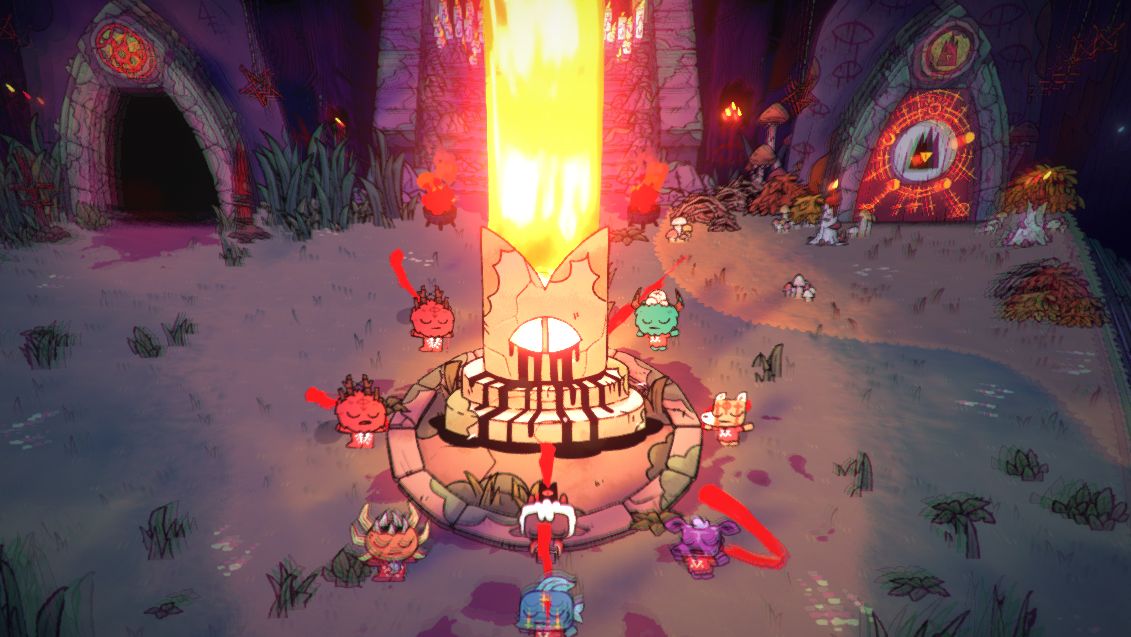When I first delved into Cult of the Lamb, I didn’t anticipate the extensive poop-shoveling I’d encounter. This game cleverly disguises itself as a base-management title wrapped in the guise of an action roguelite. It strikes a harmonious balance between these genres, presenting a charming art style and an array of engaging side activities that breathe life into its linear structure. While the combat may not offer enough depth for repeat play after completing the story, I’m grateful for the dark ritual I experienced.
Gameplay Mechanics
In Cult of the Lamb, you step into the role of a resurrected cult leader serving an imprisoned deity known as The One Who Waits. Your mission is to liberate your master by recruiting followers, building a sanctuary for them, and embarking on violent crusades against otherworldly foes. The gameplay loop—gathering resources, tending to your followers, upgrading your character and base, then repeating—is immensely satisfying. The whimsical art and lively animations inject joy into even the most ruthless tasks.
Unlike traditional roguelites such as Hades or Rogue Legacy, which often involve long, challenging runs, Cult of the Lamb features shorter crusades, averaging around 10 minutes each. Players select from four disconnected areas to explore during each run, culminating in a boss battle. This structure means the game lacks the intense roguelike tension of pushing your limits in a single, extended session.
While this brevity isn’t inherently negative, it led me to spend much of the 13 hours it took to finish building my base and completing quests rather than engaging in combat. For all the similarities Cult of the Lamb shares with a title like Dead Cells, it also bears resemblance to management games like Oxygen Not Included, and I appreciated how my decisions during expeditions were often influenced by the needs of my cultists back home.
Combat and Challenges
The combat in Cult of the Lamb is enjoyable, though relatively simple. Players utilize a single attack button, a special curse power, and a dodge-roll. The dodge mechanic, in particular, is responsive, allowing you to evade enemy attacks effectively as you battle through rooms filled with cultists and monsters. Different weapons, curses, and tarot card buffs keep each run fresh.
However, a significant drawback is the randomization of weapons and curses at the start of each crusade. You have no control over what you’ll receive, and not all options are equally viable. While reliable weapons like the sword and axe shine, slower options like the hammer can be frustrating against agile enemies. This randomness can be disheartening, especially when facing a boss with an unfavorable loadout.
Base-Building and Management
The true depth of Cult of the Lamb lies in its base-building mechanics. Defeated enemies can be recruited as followers, who then contribute by gathering resources or generating devotion through worship. Initially, you’ll do much of the manual labor, but as your cult grows, your base becomes more self-sufficient.
Both your base and character feature tech trees that unlock new structures and abilities. Over time, tasks like watering crops can be delegated to followers, allowing you to focus on more complex challenges. Managing the faith, hunger, and cleanliness of your cultists is engaging, although tracking individual follower tasks can become cumbersome as your cult expands.
Fortunately, Cult of the Lamb offers ample customization options, allowing you to rearrange buildings, change follower appearances, and adorn your camp with various decorations. This level of control fosters a sense of ownership and investment in your cult, even leading to emotional moments when favored followers meet their end—whether from old age or sacrificial rituals.
Aesthetic and World-Building
One of the most impressive aspects of Cult of the Lamb is how it embraces its quirky themes, blending cute aesthetics with dark undertones. The game features a delightful array of animal characters, from elephants to unicorns, complemented by a catchy soundtrack that sticks with you.
The world is filled with content beyond what I initially expected. With a diverse map housing shops, quests, fishing mini-games, and challenges, there’s always something to keep players engaged. The quirky character designs and variety of secrets further enhance the exploration experience.
Verdict
Cult of the Lamb is a charming yet unsettling blend of genres that harmonizes beautifully. While the combat may not offer the lasting appeal of other action roguelikes, the joy of building your cult and nurturing followers is equally rewarding. Though I may not revisit it after the credits rolled, Cult of the Lamb is a unique experience that I thoroughly enjoyed.


